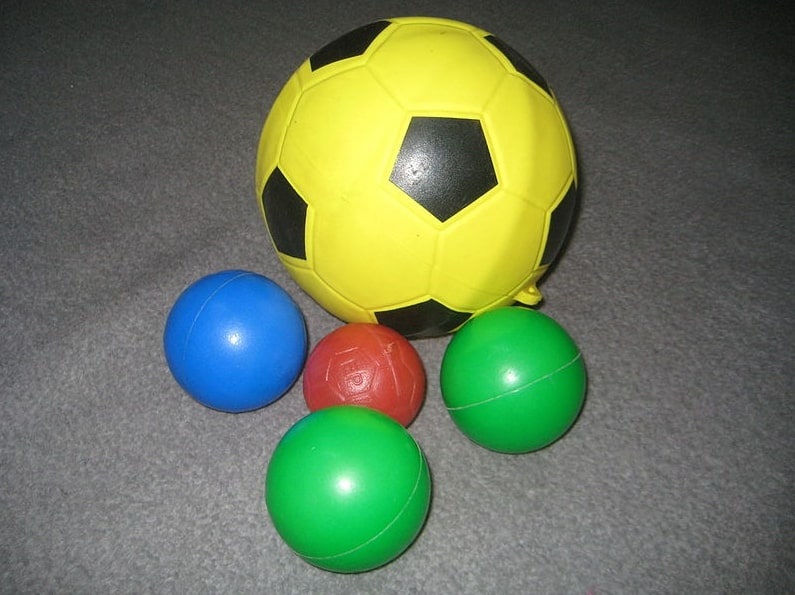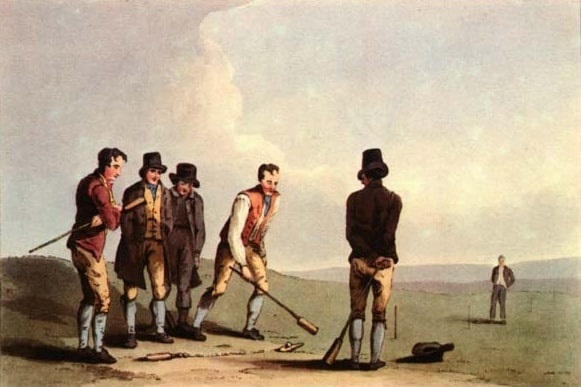Introduction: In this article, Jessica Edwards continues her series exploring the pastimes and toys our ancestors enjoyed when they were children, focusing on an English game using a ball and bat. Jessica has had a lifelong interest in her family’s history – especially on her father’s side, which goes back to the first settlers in Pennsylvania, Jamestown and New England – and has documented and added more than 27,000 people to her family tree!
In examining children’s pastimes and toys from 1700 to 1950, we’re looking at a time when children worked more and had less free time than children today. By studying how they played, we can learn about an aspect of our ancestors’ lives not often dealt with in genealogy, and help bring those names and dates on the family tree back to life.

Brief History of Balls
Most children’s first interactive toy is a ball. Balls have come in many forms over the ages, and are some of the earliest known toys – although there is a dispute about when they came about.
During recent excavations, three balls made of leather were found in graves in northern China, whose diameters all measure between 2.5 to 3 inches. Using radiocarbon dating, researchers determined the balls were up to 3200 years old. The University of Zurich released a statement by researcher Patrick Wertmann that “This makes these balls about five centuries older than the previously known ancient balls and depictions of ball games in Eurasia.”

The oldest known balls ever found were made in Egypt and are about 4,500 years old. They were made out of tied bundles of linen.
So, the two main early types of balls were those made of cloth (usually linen or canvas) or leather. (Another type of ball – that is disputed – was made from parts of animals, such as the stomach, that were cleaned and inflated, but I am not going to include them in this article.)
Paintings from ancient Greece and elsewhere show that sticks were sometimes used in ball games (in competitions that resembled hockey or lacrosse).

The Ball Game of Knurr and Spell
Knurr and Spell (also called “Northern Spell,” “Nipsy,” or “Trap Ball”): Long before baseball became the official American pastime, a variety of ball and bat game was popular in England called Knurr and Spell. According to Wikipedia:
“The game originated in the moors of Yorkshire, in England, but then spread throughout the north of England. It can be traced back to the beginning of the 14th century. It was especially popular in the 18th and 19th centuries, but was virtually unknown by the 21st century.”
The object of the game was to hit the hard golf-ball-sized ball (a “knurr”) with a stick or bat as far as possible. Usually, the field was marked with pins every 20 yards to make it easier to gauge how far a play had hit the knurr, much like a modern-day golf driving range.
The knurr (from Middle English: knurre or knot, and refers to a hardwood or pottery ball, as could be made from a knot of wood, that is the approximate size of a walnut), was propelled vertically into the air by a mechanical device (a “spell”) made of wood that was tripped when a foot or club pressed a lever (later development of the game had a spell or trap furnished with a spring, thus ensuring regularity in the height to which the knurr was tossed). The player would then swing the bat and strike the knurr as hard as they could, driving it up high and far into the marked field.
The object of the game was to hit the knurr the greatest possible distance, either in one or several hits. Each player competed as an individual, without interference, and any number could enter a competition. In matches each player supplied their own knurrs.
Family historians: Explore over 330 years of newspapers and historical records in GenealogyBank. Discover your family story. Start a 7-Day Free Trial.
Related Articles:
- Family History: Children’s Pastimes and Toys (the Letter ‘A’)
- Family History: Children’s Pastimes and Toys (the Letter ‘B’), Part 1
- Family History: Children’s Pastimes and Toys (the Letter ‘B’), Part 2
- Family History: Children’s Pastimes and Toys (the Letter ‘C’), Part 1
- Family History: Children’s Pastimes and Toys (the Letter ‘C’), Part 2
- Family History: Children’s Pastimes and Toys (the Letter ‘D’), Part 1
